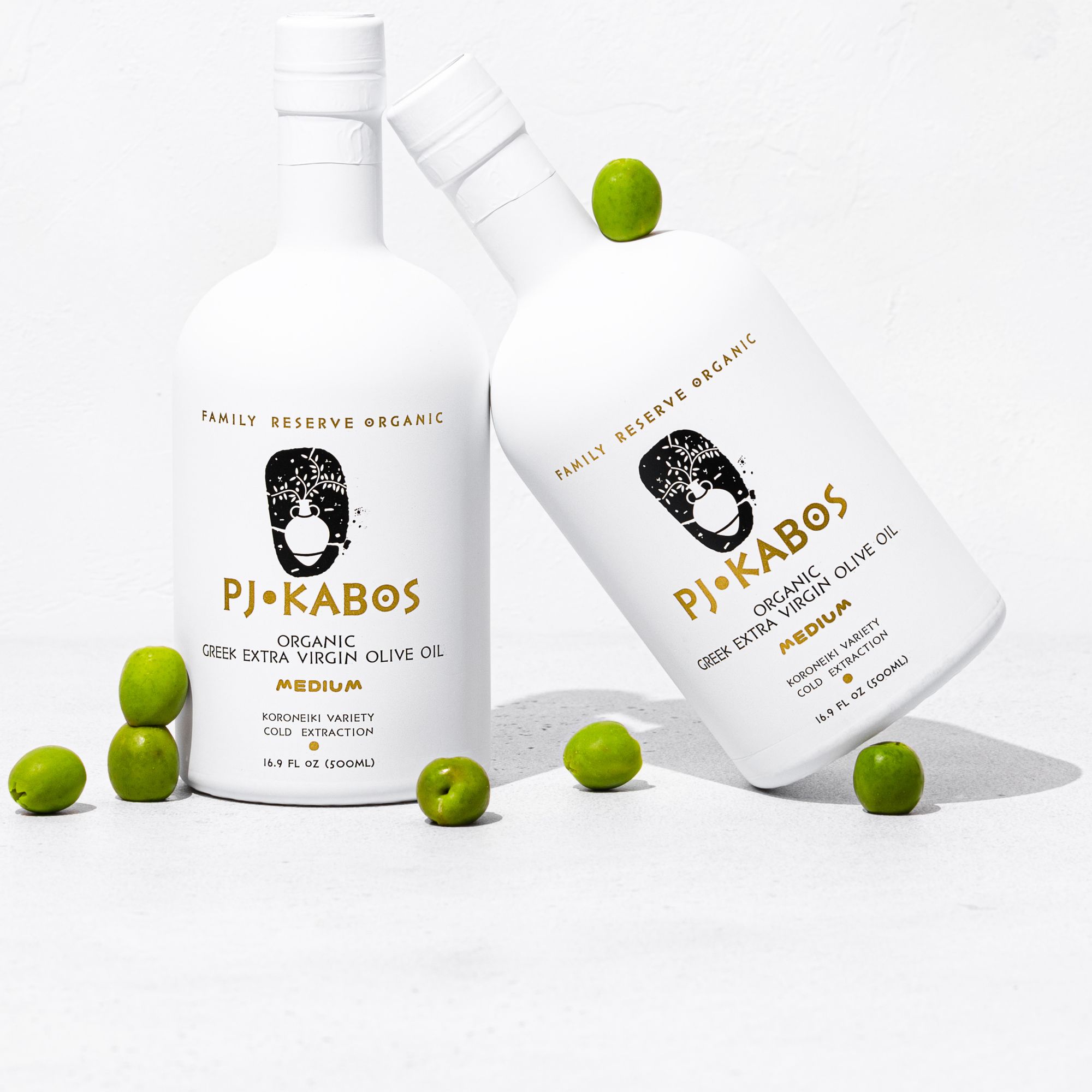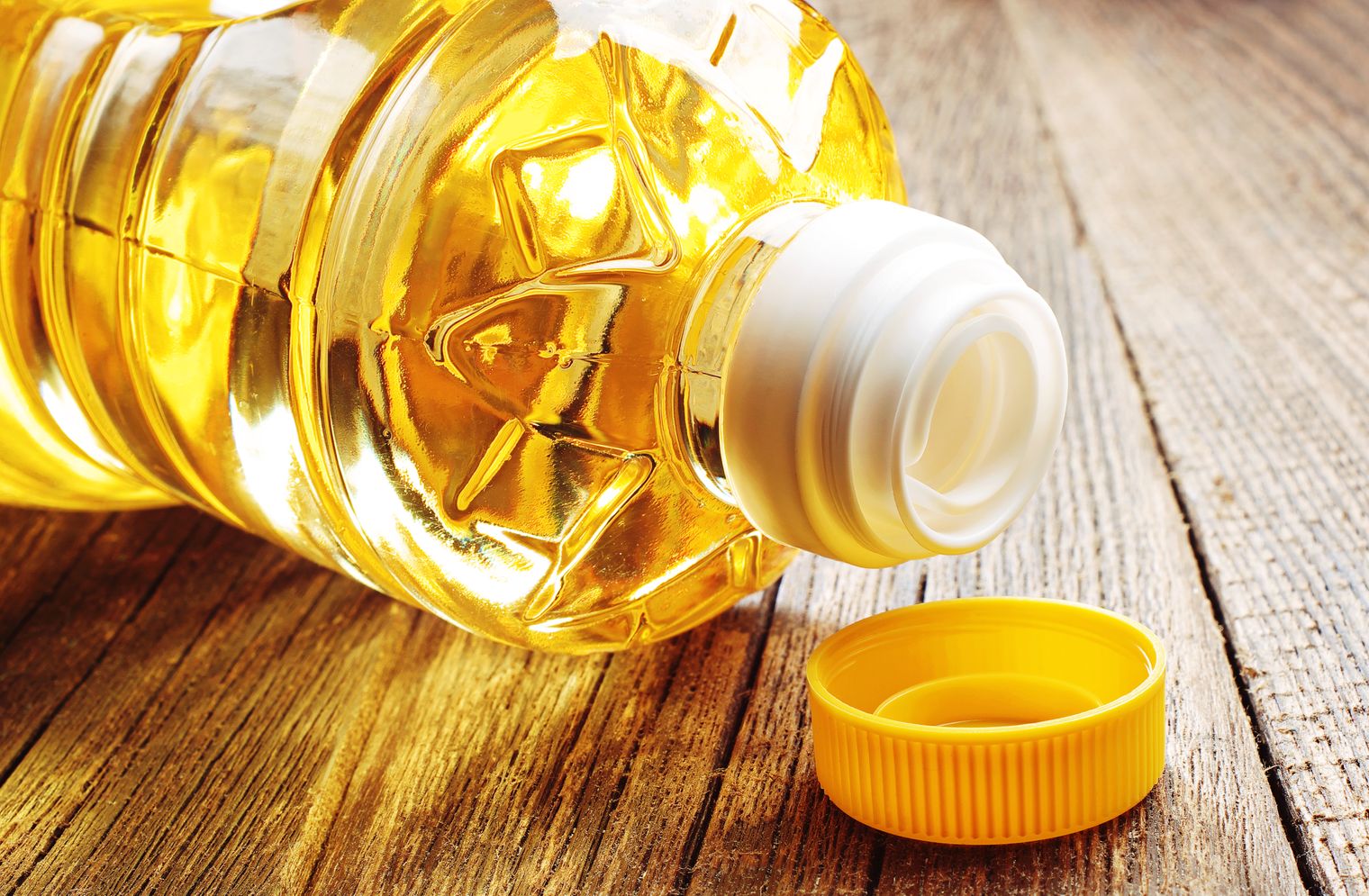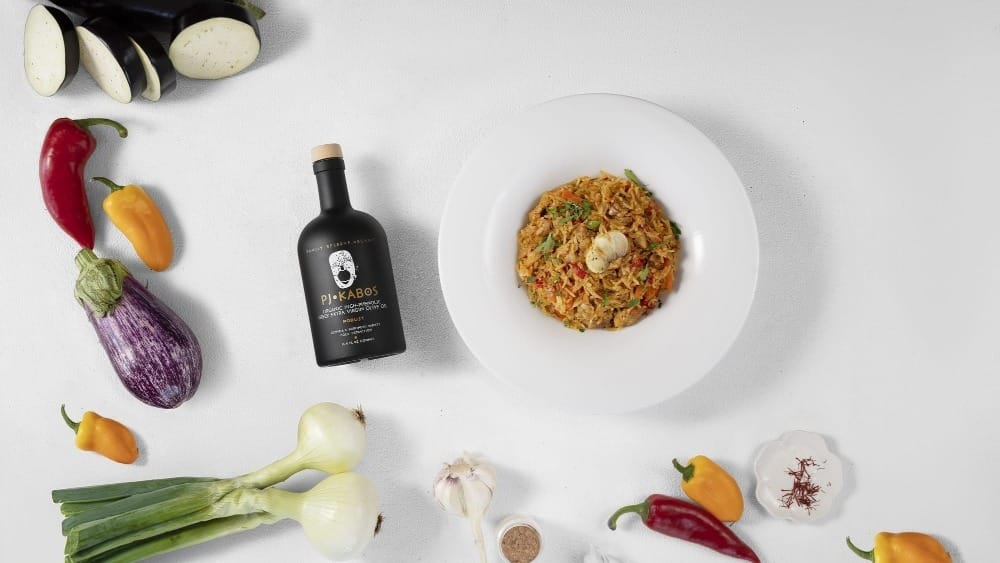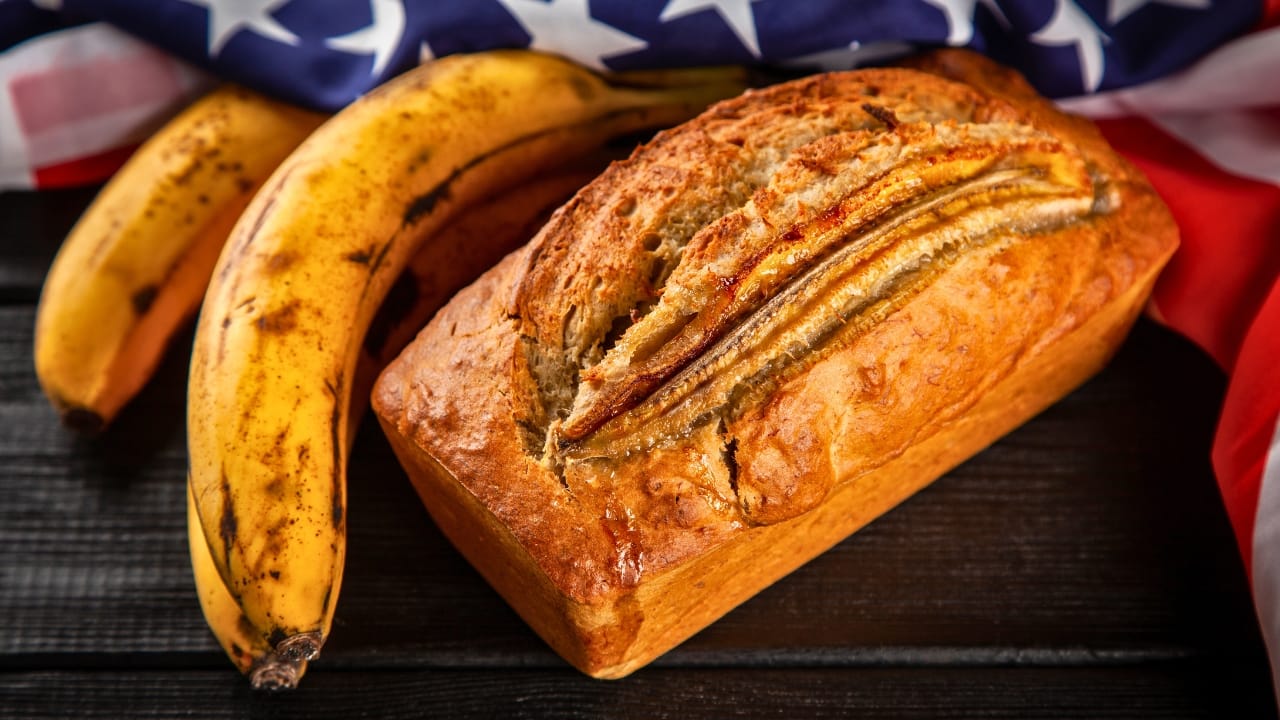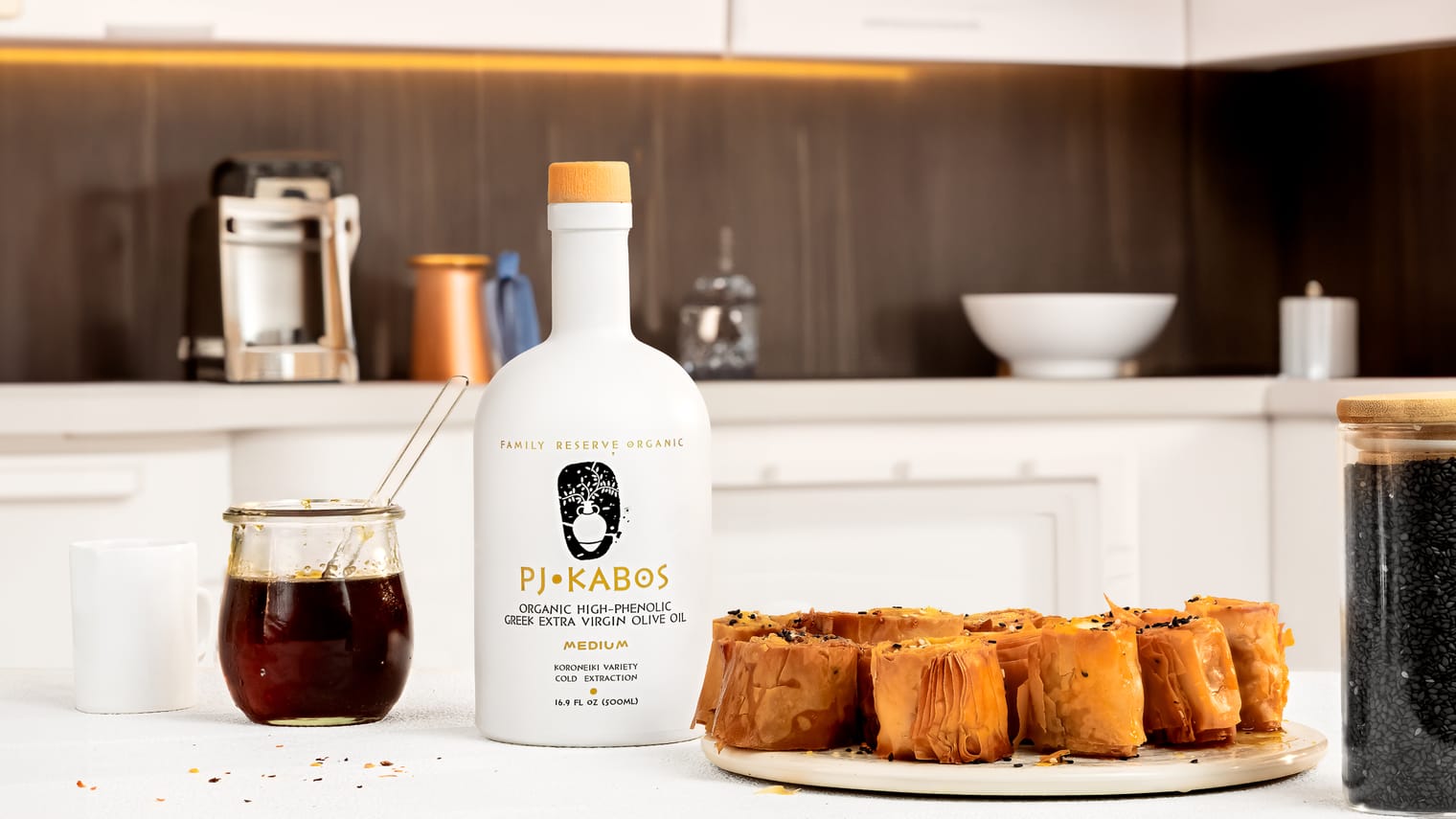Every kitchen needs cooking oil. It’s what allows you to saute veggies without them sticking, fry up pancakes to golden perfection, and give those baked goods a lovely moist texture. But choosing a cooking oil that’s both healthy and right for your recipe can be downright confusing. More often than not, people find themselves deliberating between two big contenders: Olive oil and vegetable oil.
Olive oil is both delicious and healthy. It spans a range of flavors depending on the olives used and when they were harvested—from robust, vegetal, and peppery to smooth, buttery, and subtly fruity—and it’s been associated with a ridiculous number of health benefits such as reducing risk of heart disease, reducing inflammation, lowering cholesterol, and more. And while it shines when used in raw applications (e.g. in dressings and as a finishing oil), it’s also fantastic for most cooking.
Vegetable oil, on the other hand, is a little tricky. While it may sound healthy (vegetables are nutritious, after all), it’s name is a little deceiving, as it’s a highly processed oil that’s lost most of its micronutrients during production. Vegetable oil is often recommended for cooking a wide variety of dishes, from cakes to fried chicken, due to its neutral flavor and high smoke point, but recent research suggests that it’s actually not the most stable when heated.
Here, we break down the differences in nutrition, health benefits, taste, and culinary uses for olive oil and vegetable oil, so you can decide which deserves a spot in your pantry.
Vegetable Oil & Olive Oil: How They Are Made
The production of olive oil vs vegetable oil varies quite drastically. Let’s take a look.
How is olive oil made?
In its simplest form, extra virgin olive oil and virgin olive oil is made by picking and washing the olives, grinding and mixing them into a uniform paste, separating the solids (or pomace) from the liquid oil, and filtering the oil. The oil is never exposed to chemicals or high heat during, so its flavors, aromas, and potent bioactive compounds like polyphenols are maintained.
Regular (or pure) olive oil and light olive oil are slightly more processed—they contain a blend of virgin olive oil and refined olive oil. The refined component has been treated with heat and various chemical agents to remove defects in flavor, aroma, and color.
How is vegetable oil made?
Vegetable oil is just about the most highly processed cooking oil you can buy. Typically, vegetable oil is a blend of several different oils such as soybean oil, corn oil, canola oil, safflower oil, sunflower oil, and safflower oil.
Unlike olives, foods like corn and soy can’t simply be pressed to extract their oil (since their fat content isn’t that high) so they require extensive processing. This involves grinding, bleaching, deodorizing, using chemical solvents, and exposing the oil to very high heat (sometimes past their heat tolerance, which can cause rancidity). Not only does this remove most flavor, it also destroys many healthy micronutrients, including polyphenols and antioxidants.
Nutritional Breakdown Of Olive Oil Vs. Vegetable Oil
When you first glance at the nutrition labels, olive oil and vegetable oil may seem pretty similar. The main differences lie in the types of fats and the presence of micronutrients.
Olive Oil Nutrition
Olive oil is well known for its abundance of healthy monounsaturated fats, which have been linked to reduced inflammation and improved heart health. Specifically, olive oil’s fat content may be up to 83% oleic acid, a subtype of monounsaturated fat with anti-cancer and anti-inflammatory properties, and which has been shown to reduce “bad” LDL cholesterol.
High-quality olive oil also contains contains a variety of micronutrients and bioactive plant compounds such as polyphenol antioxidants (oleuropein, hydroxytyrosol, and oleocanthal), vitamin E, phytosterols, squalene, chlorophyll, and carotenoids that have been linked to reduced inflammation and lower cholesterol. These don’t get listed on the nutrition label, but they are most abundant in EVOO and present in smaller amounts in other types of olive oil.
One tablespoon of extra virgin olive oil contains the following, according to the USDA:
- Calories: 119
- Total fat: 13.5 g
- Saturated fat: 1.9 g
- Polyunsaturated fat: 1.4 g
- Monounsaturated fat: 10 g
- Cholesterol: 0 mg
- Total carbohydrate: 0 g
- Protein: 0 g
- Vitamin E: 1.9 g (13% daily value)
Vegetable Oil Nutrition
Compared to olive oil, vegetable oil contains similar amounts of calories, total fat, and other major nutrients that appear on nutrition labels. However, vegetable oil contains a much higher ratio of polyunsaturated fats (PUFAs) to monounsaturated fats (MUFAs). PUFAs encompass two main types of fatty acids: omega-3 fatty acids and omega-6 fatty acids, but the type present in vegetable oil is almost entirely omega-6.
While omega-6 fats aren’t inherently “bad” (the body actually needs them), nutrition experts say that consuming more omega-6s than omega-3s in your diet may have a pro-inflammatory effect, since omega-6s are more prone to oxidation. Because modern diets contain high levels of PUFA omega-6 fats already (intake has almost tripled in the U.S. in the last 100 years with the advent of processed foods), using vegetable oil in home cooking will only drive that ratio further out of balance. Vegetable oil also lacks meaningful levels of micronutrients.
One tablespoon of vegetable oil contains the following, according to the USDA:
- Calories: 120
- Total fat: 13.6 g
- Saturated fat: 2.1 g
- Monounsaturated fats: 3.1 g
- Polyunsaturated fats: 7.8 g
- Cholesterol: 0 mg
- Total carbohydrate: 0 g
- Protein: 0 g
- Vitamin E: 1.1 mg (7% daily value)
Which is Better For Cooking?
In terms of cooking to maximize health benefits, olive oil is your best choice every time. If you don’t care much about nutrition and want an almost completely flavorless oil that’s very inexpensive, vegetable oil will get the job done.
We get that this might surprise you. But contrary to popular belief, olive oil actually holds up well to high temperatures because it’s composed of mainly heat-stable monounsaturated fats. The abundance of polyphenols in EVOO helps it resist oxidation, too (research has shown EVOO is actually the most stable cooking oil for these two reasons). Vegetable oils, on the other hand, are predominantly composed of polyunsaturated fats, which are prone to oxidation.
Wondering what oil is best in the following scenarios? Here’s what you can expect from each.
Baking
Extra virgin olive oil is great for baked goods if you want to add extra flavor and health benefits to your finished product. It complements savory, nutty, and fruity flavor profiles, particularly citrus (which is why we love this gluten-free lemon olive oil cake). For a smoother, more buttery finish, the Arbequina olive oil monovarietal makes a good choice. Regular, pure, or light olive oil is also good if you want a more neutral flavor and to retain some health benefits.
Vegetable oil has long been a top choice for baked goods, especially cakes, due to its neutral flavor profile. It will work perfectly fine, but it won’t add anything in terms of flavor or benefits.
Sauteing
Extra virgin olive oil is a good choice for sauteing vegetables and meats for stir-fries and other recipes if you want to infuse them with extra flavor and health benefits. Regular, pure, or light olive oils are good if you want a more neutral flavor and to retain some health benefits.
Vegetable oil will work for sauteing vegetables and meats, but it won’t add anything in terms of flavor or health benefits.
Frying
Most people assume extra virgin olive oil doesn’t hold up well to the high temperatures of frying (~350F), but you can definitely pan-fry and deep-fry with EVOO, and it lends a wonderful flavor to things like sweet potato fries, french fries, fried plantains, and eggs. For adding more subtle flavor to fried foods, regular, pure, or light olive oils work well.
However, we understand that sometimes you don’t want to add any extra flavor to fried foods. In these cases, vegetable oil may be preferable.
Marinades and Vinaigrettes
Marinade recipes often call for either olive oil or vegetable oil. Both will get the job done—the only difference is that olive oil will provide a flavorful base for your marinade, whereas vegetable oil is really just a vehicle for other flavorful ingredients (e.g. herbs, spices, garlic, vinegar, etc).
Is There A Difference In Taste?
The difference in taste between olive oil and vegetable oil is night and day. Hands down, olive oil wins in the flavor department, particularly high quality extra virgin olive oil.
EVOO made with green, unripe olives picked early in the growing season often have more intense, vibrant flavors described as pungent, grassy, herbaceous, or peppery; while ripe olives picked later in the season yield a smoother, more buttery olive oil. Cooking with EVOO imbues a subtle olive oil flavor into your recipes, but pouring it over your finished dish after it comes off the heat releases the oil’s wonderful aromas even more. Regular, pure, or light olive oils have a more neutral, subtle olive flavor, making them great for recipes where you don’t necessarily want to taste the oil, like cookies or certain cakes (like this chocolate olive oil cake.)
Vegetable oil is almost completely flavorless. That’s because, the more processing an oil undergoes, the fewer flavor compounds (and nutrients) remain. No noticeable flavors come out when vegetable oil is used in cooking, and we wouldn’t recommend it for raw applications (e.g. as a dipping oil, finishing oil, or salad dressing ingredient) because it doesn’t add anything.
Vegetable Oil vs Olive Oil Smoke Points
Here’s how the smoke point of EVOO and regular olive oil compare to vegetable oil and another popular cooking oil, canola oil.
- Extra Virgin Olive Oil: 350-410⁰ F
- Regular, Pure, or Light Olive Oil: 470⁰ F
- Vegetable Oil: 450⁰
- Canola Oil: 400⁰ F
Keep in mind: Smoke point doesn’t always correlate to how stable a cooking oil is. Even though vegetable oil has quite a high smoke point, its high concentration of polyunsaturated fats make it more prone to oxidation when heated. (Learn all about the relevance of smoke points here.)
Product placement
PJ KABOS 'Family Reserve Organic - Medium'
High Phenolic and 2022 Gold-Award Winner.
Declared as 'One of the World's Best Olive Oils'.
Click here to shop.
